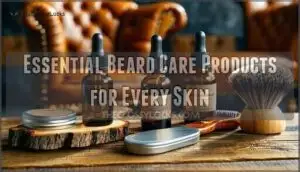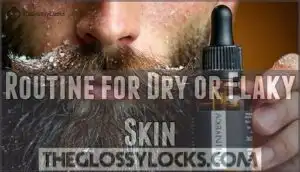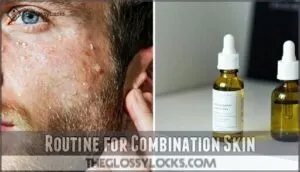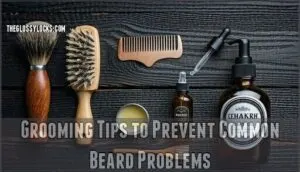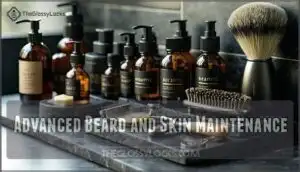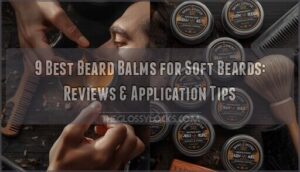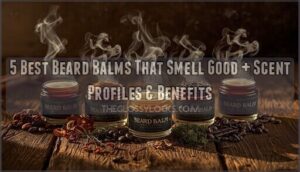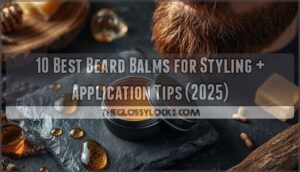This site is supported by our readers. We may earn a commission, at no cost to you, if you purchase through links.
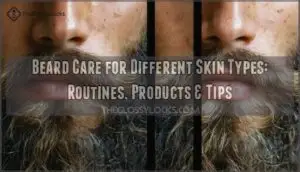
Oily skin paired with a thick beard creates different challenges than dry skin with patchy growth, yet most men use the same products regardless of their skin type. This mismatch leads to irritation, flakiness, ingrown hairs, and a beard that never looks quite right.
The solution lies in understanding how your specific skin type interacts with your facial hair, then adjusting your products and routine accordingly. When you match your beard care approach to your skin’s needs, you’ll solve persistent problems you thought were just part of having a beard.
Table Of Contents
Key Takeaways
- Your beard care routine should match your specific skin type (oily, dry, sensitive, or combination) rather than following a one-size-fits-all approach, since mismatched products cause irritation, flakiness, and ingrown hairs.
- Choosing the right beard oil depends on your skin’s needs—light oils like jojoba work for oily skin, while heavier oils like sweet almond suit dry skin, and unscented formulas help sensitive skin avoid reactions.
- Regular exfoliation (once or twice weekly) removes dead skin cells trapped under your beard, preventing dandruff, clogged pores, and irritation, with chemical exfoliants working better for oily skin and gentle physical scrubs for normal types.
- Persistent beard problems like severe irritation, chronic acne, fungal infections, or significant hair loss require professional dermatology evaluation since home remedies and over-the-counter products can only address so much.
Identifying Your Skin and Beard Type
Your skin type and beard characteristics work together like two sides of the same coin. Understanding both helps you avoid common problems like irritation, dryness, or breakouts under your beard.
Let’s break down the key factors that determine which care approach works best for you.
Common Skin Types: Oily, Dry, Sensitive, Combination
Your skin doesn’t stop at your jawline—it continues right under your beard, and understanding whether it’s oily, dry, sensitive, or combination is the first step to keeping both your face and facial hair healthy.
Oily skin produces excess sebum that can make your beard look greasy. Dry skin flakes and causes itchiness beneath facial hair. Sensitive skin reacts easily to products with redness or irritation. Combination skin shows different characteristics in different zones of your face.
Beard Thickness and Growth Patterns
Beard thickness and growth patterns vary considerably from person to person due to genetics, hormone levels, and even ethnicity. You can’t control your beard genetics, but you can work with what you’ve got.
Understanding your specific growth pattern helps you choose the right style and care routine:
- Growth rate determines how often you’ll need trimming
- Patchy growth areas may require longer beard length to fill gaps
- Hair density affects which products work best for your facial skin
- Beard texture ranges from coarse to fine, impacting styling needs
- Hair follicles distribution shapes your natural beard shape
Thicker beards trap more dirt and oil. Thinner beards expose more skin underneath.
How Skin Type Affects Beard Health
The connection between facial skin and beard health runs deeper than most people realize. Different skin conditions directly influence how well your beard grows and how healthy it looks. Oily skin can lead to clogged follicles and slower growth, while dry skin creates flaking underneath your beard. Sensitive skin reacts poorly to many beard care products, causing irritation that weakens follicle health.
Your skin type directly determines beard health—oily skin clogs follicles, dry skin causes flaking, and sensitive skin weakens growth through irritation
Your skin type also changes how products absorb—what works for combination skin won’t suit someone with consistently oily facial skin. For those with sensitive skin, it’s important to use products that are gentle and hypoallergenic.
Essential Beard Care Products for Every Skin
The right products make all the difference when you’re matching beard care to your skin type. What works for oily skin won’t necessarily help dry or sensitive skin underneath your beard.
Let’s break down the core products you need and how to choose them based on your specific needs.
Choosing The Right Beard Oil for Your Skin
Think of beard oil as medicine for your facial skin. Selecting beard oil depends on understanding skin and beard type, then matching carrier oils to your needs. Testing oil compatibility prevents reactions. A good way to start is to evaluate beard oils by testing them over a couple of weeks.
Choosing quality ingredients and picking a pleasant scent matter, but scent preferences should never override skin compatibility.
- Jojoba or argan for oily skin – Light carrier oils that won’t clog pores
- Sweet almond or coconut for dry skin – Heavier oils that deeply moisturize
- Unscented formulas for skin sensitivity – Avoid essential oils if you react easily
- Natural oil ingredients only – Skip synthetic additives and fragrances
- Patch test application techniques – Apply small amounts behind your ear first
Balms, Butters, and Conditioners Explained
While oils absorb quickly into your beard, balms and butters provide structure and hold that last through the day. Balms contain beeswax for styling control and work well for combination skin. Butters offer deeper hydration levels without hold—ideal for dry, coarse beards.
Conditioners soften beard hair during washing. Match these beard care products to your beard grooming needs and skin type for an effective beard skincare routine.
Selecting Beard Wash and Cleansers
Regular shampoo strips away natural oils your skin needs under that beard, so choosing the right cleanser matters more than you think. Pick a beard wash that matches your skin type and maintains proper pH balance.
Key factors when selecting facial cleansing products:
- Ingredients to avoid: Sulfates and harsh detergents worsen dryness and irritation
- Cleansing frequency: Oily skin tolerates daily washing; dry skin needs 2-3 times weekly
- Scent sensitivity: Fragrance-free beard care products prevent allergic reactions
Your skin type match determines which skincare product recommendations work best.
Daily Beard Care Routines by Skin Type
Your skin type determines how your beard reacts to daily care. A routine that works for oily skin can worsen dryness, while dry skin needs hydration that oily skin doesn’t.
Here’s how to tailor your daily beard care to match your specific skin type.
Routine for Oily Skin
If you have oily skin, your beard routine needs to focus on controlling excess sebum without stripping away the natural oils that keep your beard healthy.
Start with deep cleansing using a non-comedogenic beard wash to prevent pore clogging and acne breakouts. Choose lightweight, matte products that won’t add shine or feel greasy.
Apply beard oil sparingly—just a few drops—focusing on the hair itself rather than the skin beneath to maintain balance without triggering excess oil production.
Routine for Dry or Flaky Skin
Dry or flaky skin under your beard needs intensive hydration to prevent irritation, beardruff, and that uncomfortable tight feeling. Use hydrating cleansers that won’t strip natural oils.
Apply generous amounts of rich beard oil twice daily, massaging it into the skin beneath. Follow with moisturizing balms to lock in hydration.
Incorporate gentle exfoliation weekly to remove dead skin cells and reduce beard dandruff. Add a night routine with heavier moisturizers for best results.
Routine for Sensitive or Acne-Prone Skin
Sensitive skin and acne-prone skin demand a gentle approach that won’t trigger breakouts or redness. Your skin routine should prioritize calming inflammation while keeping pores clear.
- Use gentle cleansing with fragrance-free, sulfate-free beard wash to avoid skin irritation
- Choose non-comedogenic oils like jojoba or argan that won’t clog pores or worsen acne treatment efforts
- Limit exfoliating frequency to once weekly with chemical exfoliants rather than harsh scrubs
- Look for soothing ingredients like aloe, chamomile, or tea tree oil, but always practice patch testing first
Routine for Combination Skin
Combination skin can feel like you’re managing two different faces at once—an oily T-zone paired with dry cheeks creates a balancing act that requires strategic care.
Your beard care routine needs targeted products that address both zones without overcorrecting either. Use lightweight moisturizing oils on dry areas while keeping T-zone focus minimal.
Gentle exfoliation twice weekly maintains skin health, and spot treatment addresses specific concerns without disrupting your overall skincare balance.
Grooming Tips to Prevent Common Beard Problems
Most beard problems don’t just happen—they’re often the result of overlooked grooming habits or skin-specific needs. The good news is that with the right techniques, you can head off ingrown hairs, dandruff, irritation, and styling mistakes before they become real issues.
Here’s what you need to know to keep your beard and the skin underneath healthy.
Managing Ingrown Hairs and Itchiness
Ingrown hairs and persistent itchiness can turn your beard from a source of pride into a constant source of frustration. These issues stem from trapped hair follicles and skin irritation beneath your beard. Proper aftercare tips make a difference.
How to prevent and relieve these problems:
- Exfoliate weekly using gentle exfoliation methods to remove dead skin cells that trap hairs and cause inflammation
- Apply beard oil daily with product ingredients like jojoba or argan oil to soften hair and reduce skin sensitivity
- Trim regularly at proper angles to prevent hairs from curling back into your skin and forming ingrown hairs
- Use warm compresses for immediate itch relief and skin irritation relief when discomfort strikes
- Avoid scratching as this worsens beard itch and can introduce bacteria that increase inflammation
Preventing Beard Dandruff and Flakes
Beard dandruff shows up as white or yellowish flakes trapped in your facial hair, and it’s caused by dry skin, fungal overgrowth, or seborrheic dermatitis underneath your beard.
You need consistent hydration and proper beard care to tackle the causes of dandruff. Wash with anti-dandruff shampoos containing zinc pyrithione or ketoconazole twice weekly. Apply moisturizing beard oil daily for skin hydration benefits. Gentle exfoliation methods remove dead cells without irritation.
Your diet impacts skin health too—omega-3s and B vitamins support natural moisture.
Reducing Skin Irritation and Redness
Redness and irritation along your beard line signal that your skin’s barrier is compromised—usually from harsh products, rough grooming habits, or underlying sensitivity.
Switch to soothing ingredients like aloe, chamomile, or colloidal oatmeal in your beard products. Use gentle exfoliation once weekly to prevent buildup without aggravating skin redness.
Hydration importance can’t be overstated—apply lightweight moisturizers under your beard oil. Try cooling techniques like chilled jade rollers to calm inflammation.
Always patch test new products on sensitive skin first.
Beard Trimming and Styling for Healthy Skin
Proper trimming technique protects your skin just as much as it shapes your beard—dull blades and improper angles create micro-cuts that invite irritation and infection. Sharp beard shaping tools minimize trauma to sensitive skin.
Sanitize your beard grooming tools weekly to prevent bacterial transfer. Apply beard oil before trimming to soften hair and reduce pulling.
Work with your natural growth pattern when beard shaping and styling to avoid inflammation.
Advanced Beard and Skin Maintenance
Once you’ve nailed the basics, it’s time to level up your beard game. Elevated maintenance goes beyond daily washing and conditioning to include techniques that protect both your beard and the skin underneath.
Here’s what you need to know to keep your facial hair healthy for the long haul.
Exfoliation Techniques for Bearded Skin
Dead skin cells don’t just vanish when you grow a beard—they get trapped under your facial hair and create a breeding ground for irritation, flakes, and clogged pores. That’s why regular exfoliation techniques for beards matter for skin health maintenance. You need to exfoliate one to two times weekly, adjusting exfoliation frequency based on your skin type.
Here’s what works:
- Choose chemical vs physical exfoliants carefully—chemical options with salicylic acid suit oily skin, while gentle physical scrubs work for normal types
- Use a beard follicle scrub with soft bristles to lift dead cells without damaging hair or irritating skin underneath
- Look for exfoliating ingredients like glycolic acid or jojoba beads that won’t strip natural oils from your beard
- Apply light pressure in circular motions to reach the skin beneath without pulling or breaking beard hair
- Follow with post-exfoliation care using beard oil to restore moisture and protect your freshly cleaned skin
Your skincare program should adapt as your beard grows thicker.
Sun Protection and Anti-Aging for Bearded Faces
Your beard might shield your chin from harsh weather, but it doesn’t stop UV rays from damaging the skin underneath or the exposed areas around it. Apply beard sunscreen with SPF 30 or higher daily to prevent sun damage and reduce skin cancer risk.
Use anti-aging serums with vitamin C or retinol on exposed cheeks and forehead.
Hydration importance can’t be overstated—drink water and moisturize to maintain skin elasticity and minimize UV beard damage.
Nutrition and Lifestyle for Beard Growth
When beard growth stalls, looking at what you eat and how you live makes all the difference. Hair follicles need specific nutrients and healthy habits to produce strong, healthy facial hair consistently.
Key factors for prime beard growth:
- Dietary Proteins and Key Micronutrients – Consume eggs, lean meats, and legumes for keratin production. Add biotin, zinc from oysters, and vitamin D to support hair follicles and reduce patchiness.
- Hydration Levels and Sleep Quality – Drink at least 2 liters of water daily to maintain follicle function. Get 7-9 hours of sleep nightly to boost testosterone and dihydrotestosterone, which directly stimulate beard growth.
- Lifestyle Behaviors – Exercise regularly to increase testosterone. Avoid smoking and excessive alcohol, which decrease blood flow and compromise beard density. Manage stress to prevent cortisol from hindering hair growth.
When to Seek Professional Help
Some beard challenges won’t resolve with better products or lifestyle tweaks alone, and recognizing when to consult a dermatologist can save you months of frustration. Severe irritation, persistent acne, fungal infections, significant hair loss, or scarring concerns all warrant professional dermatology evaluation.
Your skin health tips from home can only go so far—acne-prone skin and chronic inflammation need targeted skin care products prescribed by specialists who understand facial hair nuances.
Frequently Asked Questions (FAQs)
Can beard dye damage sensitive skin types?
Yes, beard dye can damage sensitive skin. Ingredients like paraphenylenediamine (PPD) and ammonia commonly trigger allergy and irritation.
Patch testing 48 hours before application helps identify sensitive reactions. Natural dyes reduce risk but aren’t foolproof.
Proper aftercare solutions and hypoallergenic skin care products minimize damage.
How does humidity affect different beard textures?
Humidity impacts beard texture differently. Coarse beards may feel softer but are harder to style. Fine beards flatten and lose volume. Kinky beards tighten and shrink. Wavy beards increase in curl. Straight beards remain mostly unchanged but may feel slightly heavier.
Are silicone-based products safe for bearded skin?
Silicone-based products are generally safe for skin beneath your beard, but they can trap oil and bacteria if you have acne-prone or sensitive skin.
Product buildup is common, requiring thorough cleansing to prevent clogged pores and irritation.
Does hard water impact beard and skin health?
Hard water deposits minerals like calcium and magnesium onto hair and skin. This buildup creates a barrier that blocks moisture absorption and reduces product effectiveness.
Your beard becomes dry and brittle while the underlying skin gets irritated and flaky.
Water softener benefits include better hydration and healthier beard care results.
Can facial massage improve beard growth rate?
Like athletes who know rubbing sore muscles boosts recovery, you might wonder if facial massage speeds up beard growth. Evidence shows massage techniques may improve circulation and follicle stimulation, potentially supporting beard growth through better nutrient delivery.
However, scientific evidence remains limited, and genetics primarily determine facial hair growth rate.
Conclusion
Ironically, most men overcomplicate beard care by ignoring the simplest factor: their skin. You’ve likely spent more time researching beard oils than understanding whether your skin is oily, dry, or sensitive.
That oversight creates the problems you’re trying to fix. Effective beard care for different skin types isn’t about buying more products—it’s about choosing the right ones. Match your routine to your skin’s actual needs, and your beard will finally cooperate. The connection was always there; you just needed to acknowledge it.
- https://www.youtube.com/watch?v=HBcFFOw6x2E
- https://beardswag.com/blogs/beard-swag-blog/beard-gains-how-protein-intake-influences-facial-hair-growth
- https://www.twistedmoustache.co.uk/how-does-your-diet-affect-your-beard-growth
- https://www.verywellhealth.com/supplements-for-beard-growth-8410087
- https://pubmed.ncbi.nlm.nih.gov/39440586/

